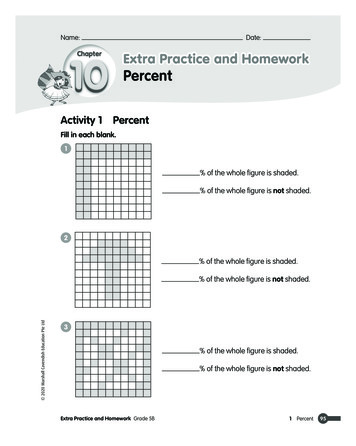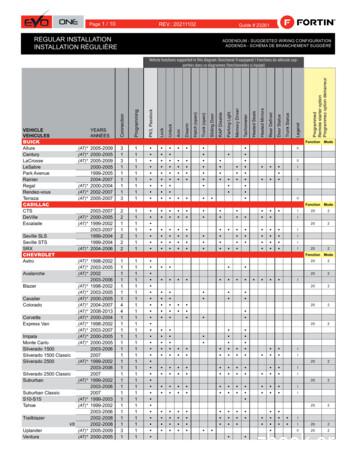Check Out Problems On Pg. 15! - Mathcounts
2018-2019playbookCheck outthis year 's mathproblems onpg. 15!
How to Use ThisPlaybookIf You’re a New Team AdvisorWelcome! We’re so glad you’re a team advisor this year.Check out the Guide for New Team Advisorsstarting on the next page.If You’re a Returning Team AdvisorWelcome back! Thank you for leading a team again.Click ahead to the 2018-2019 Program Materialsstarting on pg. 13.
Guide for NewTeam AdvisorsWelcome to the Math Video Challenge! Thank you so much for serving as a team advisor this year. We’ve createdthis Guide for New Team Advisors to help get you acquainted with the Math Video Challenge and to explain your rolein this program.If you have questions at any point during the program year, please feel free to contact the MATHCOUNTS nationaloffice at (703) 299-9006 or info@mathcounts.org.The Math Video Challenge in a NutshellThe Math Video Challenge is a national program that challenges students to develop their math, communicationand technology skills in a collaborative video project. Created in 2011, it is a completely free program and is open toall sixth-, seventh- and eighth-grade students. Students can participate through their school or through a non-schoolgroup.HOW DOES IT WORK? The Math Video Challenge is designed to be a fairly flexible program, meaning your students will spend more or less time participating in the program depending on how much they decide to do with theirvideo project. Here’s what a typical program year looks like.During the fall/winter students work in teams of 4 to create a video based on aMATHCOUNTS problem. The students must solve a problem from the 2018-2019 Math Video Challenge Playbook (pg. 15) and show a real-world application of the math concept used inthe problem. Videos can be no longer than 5 minutes; most videos are between 3 and 5 minutesin length. Students post their completed videos to the Math Video Challenge website.From mid-February through mid-March, the general public votes on the videos andthe 100 videos with the most votes advance to the judging rounds. Students can votefor their own video as often as once a day during general public voting, and they also can asktheir friends, family members and school community to vote. Teams that submit videos by thePromo Prize Pack deadline in February receive a free pack of materials to help them promotetheir video.20A panel of expert judges reviews the top 100 videos and selects 20 semifinalists toadvance to the second round of judging. Semifinalists are announced in late March; semifinalists receive certificates and recognition on the program website.In early April, expert judges select 4 finalist videos to advance to the Math VideoChallenge Finals. The 16 students who created these 4 videos, as well as each team’s advisor, receive an all-expenses-paid trip to the MATHCOUNTS National Competition, where theypresent their videos to the 224 Competition Series national competitors.At the Math Video Challenge Finals in May, the 224 Mathletes at the National Competition vote to determine the First Place Video. The 4 students who created the winningvideo each receive a 1,000 scholarship. All videos created during the contest are added tothe Math Video Challenge online archive, providing a free educational tool for students andteachers.22018-2019 MATHCOUNTS Playbook
WHAT IS EXPECTED OF THESE STUDENT-MADE VIDEOS? Each video is different and your students will nodoubt come up with lots of different creative ideas for their video. The Math Video Challenge gives students a lot offlexibility when it comes to the layout, production and content of their videos. The only requirements for the studentvideos are:Video Solves aVideo Shows aVideo Is No MoreVideo Is Created by aReal-WorldThan 5 Minutes LongTeam of 4 U.S. Students Problem from the 2018in Grades 6-82019 Math Video ChalApplication of Mathand Contains Nolenge PlaybookCopyrighted MaterialMore students can appearStudents can choose anyVideos must show howVideos cannot includein the video and the teamcan seek help from others, of the 250 problems from the math concept explored copyrighted material—suchbut only 4 students arethis year’s playbookin the handbook problem as music, images or videoofficial team members for(pg. 15). The video mustcould play out in the real clips—and must meet timea video.explain the solution to theworld.requirements.problem.When trying to gauge the calibre and general format of videos submitted to this contest, a good way to start is towatch videos in the Math Video Challenge Archive, including past semifinalists, finalists and winners. This archiveis available at videochallenge.mathcounts.org/videos. You’ll notice that the quality and style vary significantly from video to video, but all submitted videos are clearly student-made. It’s a good idea to show your students some archivedvideos, so the idea of creating a video does not seem daunting.HOW ARE VIDEOS EVALUATED IN THE CONTEST? In the first round of the contest the top 100 videos aredetermined solely based on general public voting. The 100 videos that receive the most votes between February 13and March 14 (Pi Day) advance to the judging rounds. During the judging rounds, videos are evaluated based on thefollowing criteria, in order to select the 20 semifinalists and then the 4 finalists.CreativityIs the style well-suitedfor the audience/middleschool students?Is the story engaging?Is the video memorable?Does the video s the math communicated Is an appropriate approachclearly and logically?to solving the problemIs time used effectively?used?Are important ideasAre there any errors?emphasized?Is the solution explainedIs the video easy toclearly?understand and follow?Real-WorldApplicationDoes the video present aclear, real-world application of the math conceptsin the problem?Is the real-worldscenario believable?A detailed sample assessment tool is included on pg. 50 of this playbook. You can use this to evaluate the video yourstudents create if you are using the Math Video Challenge as a group project assignment in your classroom instruction, for example, or give it to your students as a guide.2018-2019 MATHCOUNTS Playbook3
The Role of the Team AdvisorYour role as the team advisor is such an important one, but that doesn’t mean you need to be a math expert or treatadvising a team like a full-time job. Every team is different and you’ll find the style that works best for you and your students. Some students may need more help completing this project than others. But in general every MATHCOUNTSteam advisor must do the following. Initiate the registration process online and oversee the process to ensure parent/guardian approval is obtainedfor all 4 student team members. Provide guidance and suggestions, as needed, to the students working on videos. Ensure students are aware of program deadlines (such as general public voting and video submission). Review the students’ video to ensure the content is appropriate and approve the video online so it can be officiallysubmitted to the contest. Accompany the students to the National Competition, if the students’ video is selected as a finalist in the contest.You don’t need to know how to solve every MATHCOUNTS problem to be an effective team advisor. In fact, workingthrough the solution carefully is a crucial part of the Math Video Challengeprogram. Chances are, you’ll learn with and alongside your students throughout the program year.You don’t need to spend your own money to be an effective team advisor.Your students do not need expensive video equipment to participate in thisprogram. Many videos submitted to the contest are filmed on smartphones.There are also lots of free video editing software programs you and your students can use. Many students and teachers also have used equipment andsoftware for free through their school’s media center or a public library.The next sections of this Guide for New Team Advisors will go into more detailon what participation in this program entails and how to create a video usingthe free resources provided by MATHCOUNTS.Register for theNational Math Club toget even more mathresources forfree! Learnmore onpg. 53.What Participation Means in This ContestThe Math Video Challenge is designed to work for lots of different groups. What participation looks like for your students will depend, to some extent, on how far they hope to advance in the contest. This section will go into a little moredetail about team formation and registration, as well as video submission and approval.WHAT DO I NEED TO KNOW ABOUT FORMING A TEAM? Because of the nature of this contest, the way MathVideo Challenge teams are formed is different from typical math competitions. Here is what is most important to keepin mind when establishing a team for this program. A team in the program consists of exactly 4 students. Students can be on more than 1 team. For example, if you have 6 interested students, they could form 2 teams,with 2 students participating on both teams. A team can create more than 1 video. A team of students can make as many videos as they like. Teams cannot combine to make 1 video together. The minimum number of videos created per team is 1. A team advisor can oversee more than 1 team. For example, some math teachers will make the Math Video Challenge a group project that is included in their classroom instruction. In these cases, 1 teacher serves as the teamadvisor for multiple teams.When forming a team, it’s a good idea to consider different students’ skills, interests and strengths. For example, onestudent may take the lead on script writing, while another student may write an excellent solution to the problem. Partof what makes this program great is that it allows students to collaborate and showcase a diversity of talents.takeadvantage of this when forming teams!42018-2019 MATHCOUNTS Playbook
HOW DO I REGISTER A TEAM? The online nature of this contest necessitates that each of the 4 student teammembers get permission from a parent/guardian to participate. This adds an extra step to the registration process, butit’s a really important one. Here’s how the Math Video Challenge registration process works:TeamAdvisorTeam advisor registers at videochallenge.mathcounts.org/register.The team advisor must have a working email address in order to register a team of students for this program.Team advisor creates a new team on the program website.A team advisor can lead more than 1 team. If you are leading multiple teams, you wouldrepeat this step (and each subsequent step) for each team, so all of your teams arelinked to your team advisor account.Team advisor requests parent/guardian permission for each student teammember—either online or offline.When you create a new team, you’ll indicate how each team member’s parent will givepermission for his/her child to participate. Online Permission: The team advisor provides the parent’s email address online.MATHCOUNTS emails the parent a link to an online permission form. Offline Permission: The team advisor provides the parent’s first and last name onlineand then gives the parent the Offline Permission Form (the form is included in thisplaybook on pg. 52.Parent/guardian of each student team member completes the permissionform—either online or offline—and submits it to MATHCOUNTS.Instructions for submitting this form are provided to the parent/guardian.Team’s registration is complete once parent permission is received for allstudents on the team.MATHCOUNTS will email a notification to the team advisor once the team’s registrationis complete.WHAT DO I NEED TO KNOW ABOUT SUBMITTING AND APPROVING A VIDEO? After your team’s registration is complete, you’ll receive an email confirming that your team is registered and can submit videos online for thecontest. Included in this email will be an access code for uploading videos, which is unique to your team (if youare leading multiple teams, then you’ll get an emailed access code for each team you register).Once your students have completed their video (refer to the next section of this guide for detailed information aboutcreating a video for the contest), either a student team member or you as the team advisor can upload it to the MathVideo Challenge website.If A Team Advisor Submits the Video: The team advisor should be logged into the Math Video Challenge website.If the team registration has been completed, then the Upload a Video button will appear. Click the button to uploadyour video to the contest site. After the video upload is complete, you will need to approve the video separately. Youcannot approve and submit the video at the same time, and the site will require that you watchthe video in its entirety before approving it.If A Student Team Member Submits the Video: In order for a student team member to upload the team’s video,you must share the access code for uploading videos with him/her. The access code is included in an email sent toyou after your team’s registration is complete, and if you are logged in as a team advisor, it also is listed on your account next to the team’s information.2018-2019 MATHCOUNTS Playbook5
Once the student has the access code, s/he should go tovideochallenge.mathcounts.org/upload-video. S/he shouldenter the access code and then click the Go to Upload Formbutton. From there, the student will be able to upload thevideo to the contest site.Once the student has uploaded the team’s video, you willreceive an email notification that the video needs to be approved. To approve the video, log into your team advisor account. You will need to watch the video in its entirety beforeyou can approve it.It’s important to check the content of the students’ video before approving it online. As the team advisor, you mustreview the video to ensure that it is appropriate and follows the contest rules.Producer's Checklist forCreating a VideoCreating a video is so much fun and allows students to tap into their technology, art and communications talentswhile building their math skills at the same time. Although your students will create the video for this program, you asthe team advisor will likely need to guide your students or give them suggestions—especially if your students hope toadvance to the semifinals or finals.To make it easier to keep track of what video production entails, we have created a sort of Producer’s Checklist,based on feedback from past participants about their video making process. We recommend reading through thechecklist yourself and sharing its contents with your students.Please note, these steps are suggestions—not requirements. Different teams will have different methods forcreating a video and you’ll find what works best for you and your students. This checklist should be considered aresource for the Math Video Challenge, not a list of requirements.THE 10 MOST IMPORTANT STEPS WHEN CREATING A VIDEO:62018-2019 MATHCOUNTS Playbook
1. Pick a math problem.Use this year’s playbook problems on pg. 15.2. Write the solution(s) to the math problemExplore different solutions to the problem.6. Write the script for your video.Keep the 5-minute time limit in mind.7. Do a timed table-read andrun-through to practice.Practice a few times before filming anything!3. Brainstorm story ideas.Use the graphic organizers on pgs. 46-47.8. Shoot your video.Be sure to avoid common pitfalls!Some are listed on pg. 11.4. Plan out the where, when and how offilming, costumes, sets and editing.Get the logisitics in order before gettingtoo far along in the project.9. Edit your video and adddesired special effects.Make sure your video does not includeany copyrighted material!TO DO5. Create a storyboard for your video.Use the storyboarding template on pg. 48.10. Show the final product to someonewho hasn’t seen the video before.Based on his/her feedback, make anynecessary changes.The remainder of this section (pgs. 8-12) provides a little more detail about each of these 10 steps.2018-2019 MATHCOUNTS Playbook7
STEP 1: PICK A MATH PROBLEM. This may sound like an obvious step, but choosing your problem carefully isvery important. When your students are deciding which math problem they want to solve in their video, it’s importantthey think about questions like: How would we explain the solution to this problem in our video? How long would it take toexplain it well? Is there a real-world application we can imagine for this problem? Do we want to create ourown real-world scenario or use a problem that already has some sort of scenario? Can we come up with an interesting and memorable story for this math problem?It’s important that your students choose only from the 250 problems in this year’s playbook. You can findthe problems in this playbook, starting on pg. 15. You’ll notice that the playbook problems do not go in sequentialorder. This is because we have modified the 2018-2019 MATHCOUNTS School Handbook to work better for theMath Video Challenge. Instead of separating problems into Warm-Ups, Workouts and Stretches—which are intendedfor the MATHCOUNTS Competition Series—we have separated them into categories by math topic. If you and yourstudents would rather use the traditional handbook setup, you can access it at www.mathcounts.org/handbook.STEP 2: WRITE THE SOLUTION(S) TO THE MATH PROBLEM. After your studentshave decided which problem they want to solve, they should write a detailed, completesolution, which will be the basis of their video. The answers to all 250 problems are included in this playbook starting on pg. 36.Use the InteractiveMATHCOUNTSPlatform to get detailedsolutions for this year'splaybookproblems allfor FREE!If your students are having difficulty working through the solution to theirproblem, a great resource is the Interactive MATHCOUNTS Platform,powered by NextThought. This free online resource allows students to workthrough current and past MATHCOUNTS problems, chat with other students about strategies and get step-by-step solutions to all 250 of thisyear’s handbook problems. Students and team advisors can sign up for freeat mathcounts.nextthought.com. Learn more on pg. 41.Many MATHCOUNTS problems can be solved in different ways. Encourageyour students to think through multiple ways to explain the solution to theproblem, so they are sure to include the one they believe is best. However,including multiple solutions in the video may make it more memorable, interesting or clear.STEP 3: BRAINSTORM STORY IDEAS. Let your students’ creativity loose during this step! Have students thinkof different scenarios or stories they could use to give context to the math problem they chose. We have included afew graphic organizers you and your students can use to map out ideas (pgs. 46-47).This step also lends itself to collaboration, as the students will need to work together to comeup with an idea everyone is excited about. Encouraging students to cooperate and listen toeach other’s ideas will help them come up with great ideas for their video, and also will setthem up for success when they need to collaborate later on the filming and editing of theirvideo.It’s really important to stress to the students that they do not have to use the context provided in aparticular problem to create their video. Students can change the names of the characters, locations, propsor objects discussed, and even the activity the characters in the problem are doing. As long as the same problem issolved, and it is clear which handbook problem the video explains, the students are allowed to change the context ofa handbook problem for their video.On the next page are a few examples of how a problem could be changed for this program.82018-2019 MATHCOUNTS Playbook
Problem #62 from the 2014-2015 MATHCOUNTS School Handbook: Original Problem Text: The Statesville Middle School basketball team has 8 players. If a player can play any position, in how many different ways can 5 s
Accompany the students to the National Competition, if the students’ video is selected as a finalist in the contest. You don’t need to know how to solve every MATHCOUNTS problem to be an effective team advisor. In fact, working through the solution carefully is a crucial part of the Math Video Challenge program.
1 Problems: What is Linear Algebra 3 2 Problems: Gaussian Elimination 7 3 Problems: Elementary Row Operations 12 4 Problems: Solution Sets for Systems of Linear Equations 15 5 Problems: Vectors in Space, n-Vectors 20 6 Problems: Vector Spaces 23 7 Problems: Linear Transformations 28 8 Problems: Matrices 31 9 Problems: Properties of Matrices 37
Round Value Check-In/Check-Out: Defines the smallest unit for rounding the time of check-in/check-out. For example, if Round Value In/out is set to 10, the smallest unit of time that can be included in attendance records is 10 minutes. Round Down Check-In/Check-Out: Rounds up values greater
1. Check for oil, fuel or water leaks. 2. Drain oil and replace f ilter.(see oil change). pg. 15-17 3. Check and re{ighten engine mount bolts. 4. Check fuel line f ittings for tightness. 5. Check hose clamPs and hoses. 6. Check the alternator belt for correct tension' 7. Check throttle linkage. B. Check the flame arrestor' 9. Check the fuel .
3 Mechanic Flight Approval 01 Line/Check 1 Post Flig ht 2 Through Flight 3 Line Check (Thru-Flight) 4 Line Check (Over-Night) 12 03 Engine/Systems Check 1 Engine Operation Check 2Power Profile Check 3 Engine Powered Systems Check 04 Avionics/Electrical Check 1 Avionics/Electrical 2 Avionics 3 Electrical 05 06 Area/System Scheduled Checks
CHEMICAL KINETICS & NUCLEAR CHEMISTRY 1. Theory 2. Solved Problems (i) Subjective Type Problems (ii) Single Choice Problems (iii) Multiple Choice Problems (iv) Miscellaneous Problems Comprehension Type Problems Matching Type Problems Assertion-Reason Type Problems 3. Assignments (i) Subjective Questions (ii) Single Choice Questions
7 Shade 50% of the whole figure. 8 Shade 75% of the whole figure. Fill in each blank. 9 43 out of 100 % 10 out of 100 1% 11 5 out of 100 % 12 out of 100 10% 13 90 out of 100 % 14 out of 100 87% 15 21 out of 100 % 16 out of 100 2% 17 8 out of 100 % 18 out of 100 3% 19 4 out of 100 % 20 out of 100 9% 21 35 out of 100
Yellow In A1 Purple Out A2 Purple/White Out A3 Green Out A4 White Out A5 Orange Out A6 Orange/Black Out A7 Dk.Blue Out A8 Red/Blue In A9 Lt.Blue/Black In/Out A10 Black In A11 Pink Out A12 Yellow/Black Out A13 Brown/White In A14 Pink/Black In A15 Purple/Yellow In/Out A16 Green/White In/Out A17 Green/Red In/Out A18 White/
QUALITY AUDIO VISUAL INC 09/01/2015 Paper Check 25.00 QUALITY SOUND & COMMUNICATION 09/01/2015 Paper Check 153.50 RBC MUSIC CO INC 09/01/2015 Paper Check 73.98 REYNOLDS MANUFACTURING CORP 09/01/2015 Paper Check 2,694.60 ROADRUNNER TRAFFIC SUPPLY INC 09/01/2015 Paper Check 35.18 Rockin G Drywall & Construction 09/01/2015 Paper Check 18,365.00


















